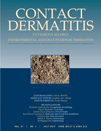
CONTACT DERMATITIS
Scope & Guideline
Transforming Understanding of Skin Reactions
Introduction
Aims and Scopes
- Allergic Contact Dermatitis:
The journal extensively covers research related to allergic contact dermatitis, including its causes, mechanisms, and clinical presentations. This includes various allergens such as metals, cosmetics, and topical medications. - Occupational Skin Diseases:
A significant focus is placed on occupational contact dermatitis, analyzing exposure risks in various professions, and the implications of such exposures on skin health. - Epidemiological Studies:
The journal publishes studies on the prevalence and incidence of contact dermatitis, utilizing both retrospective and prospective cohort studies to understand the epidemiological trends and risk factors. - Patch Testing Methodology:
Research on patch testing techniques, their efficacy, and advancements in testing protocols is a core area, providing insights into the best practices for diagnosing contact allergies. - Emerging Allergens and Sensitizers:
The journal highlights new and emerging allergens, tracking changes in sensitization patterns and their clinical relevance, including allergens found in cosmetics and personal care products. - Patient Education and Management Strategies:
It emphasizes the importance of educating patients about contact dermatitis, including prevention strategies and management options for individuals with chronic conditions.
Trending and Emerging
- Impact of COVID-19 on Skin Health:
There is a growing body of research examining the effects of increased hand hygiene and the use of personal protective equipment during the COVID-19 pandemic, resulting in a rise in cases of hand eczema and other dermatitis. - Novel Allergen Identification:
Emerging studies are increasingly focused on identifying and characterizing new allergens, particularly in everyday products like cosmetics and adhesives, indicating a shift towards understanding contemporary sensitization trends. - Machine Learning in Diagnosis:
The integration of machine learning and artificial intelligence into the diagnosis and management of contact dermatitis is a growing trend, showcasing advancements in technology to enhance clinical practices. - Environmental and Occupational Exposure Studies:
Research examining the effects of environmental factors and occupational exposures on skin health is on the rise, reflecting an increased awareness of the workplace's role in skin disease. - Personalized Treatment Approaches:
There is an emerging focus on personalized treatment strategies for contact dermatitis, emphasizing tailored management plans based on individual patient profiles and sensitivities. - Longitudinal Studies on Chronic Conditions:
The trend towards longitudinal studies that track the progression of chronic contact dermatitis over time is increasing, providing valuable insights into long-term management and patient outcomes.
Declining or Waning
- Traditional Allergen Sources:
Research on traditional allergens, such as nickel and certain preservatives, is becoming less frequent as newer allergens gain attention and as awareness of these older allergens becomes more established. - General Reviews of Allergy Mechanisms:
Papers providing broad overviews of allergic mechanisms without specific contextual applications are less common, as the journal shifts focus towards more detailed, clinical, and epidemiological studies. - Cosmetic Ingredients:
The focus on cosmetic allergens that were once prevalent is waning, possibly due to stricter regulations and a shift towards identifying less common allergens in newer cosmetic formulations. - Localized Studies Without Broader Implications:
There is a noticeable reduction in localized studies that do not attempt to draw broader implications or conclusions, as the journal increasingly emphasizes research with widespread clinical relevance.
Similar Journals
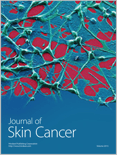
Journal of Skin Cancer
Exploring Breakthroughs in Skin Cancer PathogenesisThe Journal of Skin Cancer, published by HINDAWI LTD, serves as a vital platform for advancing knowledge in the fields of Dermatology and Oncology. Established as an Open Access journal since 2011, it ensures wide dissemination of research findings, making significant contributions to the understanding of skin cancer pathogenesis, diagnosis, and treatment strategies. The journal holds a respectable rank within the academic community, reflected in its Q3 category placement in both Dermatology and Oncology for 2023, as well as its Scopus rankings, which place it in the 49th and 34th percentiles, respectively. Targeting an audience that includes researchers, healthcare professionals, and students, the Journal of Skin Cancer not only aims to present original research but also solicits reviews and case studies, thereby fostering a rich academic dialogue. With its headquarters located in London, England, the journal encourages global engagement and collaboration among scholars committed to improving outcomes in skin cancer.
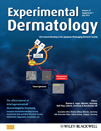
EXPERIMENTAL DERMATOLOGY
Leading the Charge in Dermatological DiscoveriesEXPERIMENTAL DERMATOLOGY, published by WILEY, is a leading journal in the fields of Biochemistry and Dermatology, with impressive rankings including Q1 status in both categories as of 2023. With its ISSN 0906-6705 and E-ISSN 1600-0625, the journal offers a reputable platform for disseminating cutting-edge research and insights into skin biology and related health issues. As a pivotal resource for professionals, researchers, and students alike, EXPERIMENTAL DERMATOLOGY includes a broad scope of topics, fostering a deeper understanding of dermatological conditions and enhancing new therapeutic strategies. The journal’s distinguished performance is highlighted by its Scopus rankings, which place it at the 91st percentile in Medicine-Dermatology and the 65th in Biochemistry. While not an open-access publication, the journal remains committed to ensuring the accessibility of crucial developments within the dermatological community worldwide, facilitating the advancement of both clinical practice and academic inquiry.
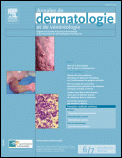
ANNALES DE DERMATOLOGIE ET DE VENEREOLOGIE
Pioneering Research in Dermatology and VenereologyANNALES DE DERMATOLOGIE ET DE VENEREOLOGIE is a distinguished journal that serves as a vital platform for disseminating innovative research and insightful reviews in the field of dermatology and venereology. Published by MASSON EDITEUR, this journal has been a cornerstone for professionals and researchers since its inception in 1977, offering a wealth of knowledge that spans decades. With its ISSN 0151-9638 and E-ISSN 2214-5451, it is indexed within leading databases, ensuring that the published work reaches a broad audience. The journal currently holds a Q3 ranking in the dermatology category, reflecting its commitment to quality and rigorous peer-review processes. While the journal is not open access, it provides an extensive archive of valuable studies that contribute to advancements in skin health and treatment methodologies. Located in Issy-les-Moulineaux, France, ANNALES DE DERMATOLOGIE ET DE VENEREOLOGIE continues to attract submissions from esteemed professionals, enhancing its reputation as a crucial resource for those dedicated to the ongoing development of dermatological sciences.

JOURNAL DER DEUTSCHEN DERMATOLOGISCHEN GESELLSCHAFT
Empowering knowledge in the field of dermatology.JOURNAL DER DEUTSCHEN DERMATOLOGISCHEN GESELLSCHAFT, published by Wiley, is a prominent periodical in the field of dermatology, recognized by its Q2 quartile ranking in the 2023 dermatology category. With a dedicated focus on advancing knowledge in dermatological science, the journal publishes rigorous peer-reviewed research that encompasses a range of topics including clinical studies, research methodologies, and innovative treatment practices in dermatology. Its impact is reflected in its Scopus ranking, where it stands at #48 out of 142 in the medicine dermatology category, placing it in the top 66th percentile. Although not an Open Access journal, it serves as a critical resource for researchers, clinicians, and students alike, facilitating the dissemination of high-quality research findings and fostering a deeper understanding of dermatological conditions and treatments. With years of convergence from 2003 to 2024, this journal remains a vital platform for scholarly dialogue and discovery in dermatology.
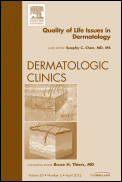
DERMATOLOGIC CLINICS
Advancing Dermatologic Knowledge for a Healthier TomorrowDERMATOLOGIC CLINICS is a leading journal in the field of dermatology, published by W B SAUNDERS CO-ELSEVIER INC. Since its inception in 1983, the journal has consistently provided a platform for the dissemination of high-quality research and clinical insights, earning its place in the prestigious Q1 quartile for dermatology in 2023. With a Scopus ranking of #34 out of 142 in its category and a commendable 76th percentile, DERMATOLOGIC CLINICS remains essential reading for clinicians, researchers, and students alike. The journal features comprehensive reviews and original articles that address the latest advancements and challenges in dermatologic diagnostics and treatments. Though it does not offer Open Access, it is widely accessible ensuring a broad readership. With a commitment to advancing the understanding of skin disorders, DERMATOLOGIC CLINICS continues to uphold its legacy of excellence in dermatological scholarship.

Actas Dermo-Sifiliograficas
Connecting Scholars to the Frontiers of Dermatological ScienceActas Dermo-Sifiliograficas, published by Elsevier España, stands as a pivotal resource in the realms of dermatology, histology, and pathology and forensic medicine. With its ISSN of 0001-7310 and E-ISSN 1578-2190, this esteemed journal has transitioned to an Open Access model since 2020, facilitating broader dissemination of impactful research. Operating from its Madrid headquarters, it has been a vital platform for scholarly exchange since its inception in 1945, continuing through its converged years until 2024. The journal holds a Q3 ranking in dermatology, histology, and pathology and forensic medicine as of 2023, reflecting its relevance in the academic community where it ranks 79th in dermatology and 126th in pathology among its peers. With a commitment to advancing knowledge and practice in its fields, Actas Dermo-Sifiliograficas serves as an essential repository for researchers, professionals, and students seeking to engage with the latest findings and innovative perspectives in skin and disease research.

Dermatology Reports
Pioneering research for transformative dermatological practices.Dermatology Reports is a reputable open-access journal dedicated to advancing the field of dermatology through innovative research and clinical studies. Published by PAGEPRESS PUBL, this journal has been providing unrestricted access to valuable scientific content since 2009, promoting the dissemination of cutting-edge knowledge among researchers, professionals, and students alike. With an ISSN of 2036-7392 and an E-ISSN of 2036-7406, Dermatology Reports is indexed in Scopus, currently holding a rank of 93/142 in the Medicine - Dermatology category, placing it in the 34th percentile. The journal, based in Italy at MEDITGROUP, VIA G BELLI, 4, PAVIA 27100, aims to foster a multidisciplinary approach to dermatological research and practice, with a vision to converge various aspects of the field from 2010 to 2024 and beyond. With its Q3 quartile ranking in 2023, Dermatology Reports stands as a critical platform for highlighting novel findings and therapeutic strategies that shape the future of dermatological science.

Dermatologie
Empowering Knowledge in Skin Disease ManagementDermatologie, published by SPRINGER HEIDELBERG, is a prominent journal dedicated to the advancing field of dermatology. With its ISSN 2731-7005 and E-ISSN 2731-7013, this journal has established itself as a valuable resource for researchers, professionals, and students alike. Originating in Germany, the journal focuses on disseminating innovative research from 2022 to 2024, contributing significantly to the understanding of skin health and disease management. Despite its current ranking within the Q3 category in dermatology and a Scopus rank of #88/142, it provides critical insights and advances in clinical practice, epidemiology, and therapeutic modalities. With an emphasis on open discourse, it seeks to foster collaboration among healthcare professionals and researchers, thereby enhancing the quality and accessibility of dermatological research. Engage with Dermatologie to stay at the forefront of the latest advancements in skin-related health issues.

AMERICAN JOURNAL OF DERMATOPATHOLOGY
Illuminating Pathways in Skin Disease ResearchAMERICAN JOURNAL OF DERMATOPATHOLOGY, published by Lippincott Williams & Wilkins, is an essential resource for professionals and researchers engaged in the fields of dermatology, pathology, and forensic medicine. Established in 1979, the journal aims to disseminate cutting-edge research and advancements pertaining to the microscopic examination of skin disorders. With an esteemed impact factor that positions it well within the Q3 category of dermatology and pathology as of 2023, the journal ranks #81 out of 142 in dermatology and #130 out of 208 in pathology according to Scopus. Although it does not currently offer open access options, the journal provides valuable insights and substantial contributions to the understanding of dermatopathology, making it a vital tool for academics, clinicians, and students seeking to stay abreast of the latest findings and practices in the field. Its commitment to high-quality research continues to foster a deeper understanding of skin diseases, enhancing patient care and scientific inquiry alike.

Dermatitis
Elevating Standards in Skin Health ResearchDermatitis, published by MARY ANN LIEBERT, INC, is a leading journal that focuses on the study of skin inflammation and allergic reactions, making significant contributions to the fields of Dermatology, Immunology, and Allergy. With an ISSN of 1710-3568 and an E-ISSN of 2162-5220, this peer-reviewed journal serves as a critical platform for researchers, healthcare professionals, and students alike, eager to share and explore groundbreaking findings and developments. Recognized for its impact and rigorous scholarly standards, Dermatitis has achieved a Q2 quartile ranking in dermatology and a Q3 ranking in immunology and allergy as of 2023, underscoring its significance in these vital medical sectors. The journal's Scopus ranking places it in the 84th percentile for dermatology and the 50th percentile for immunology and allergy, reflecting its wide acceptance and influence. With a scope spanning from 2004 to 2024, Dermatitis invites original research, reviews, and clinical updates that advance the understanding of skin disorders and therapy innovations, solidifying its role as an essential resource in enhancing skin health worldwide.